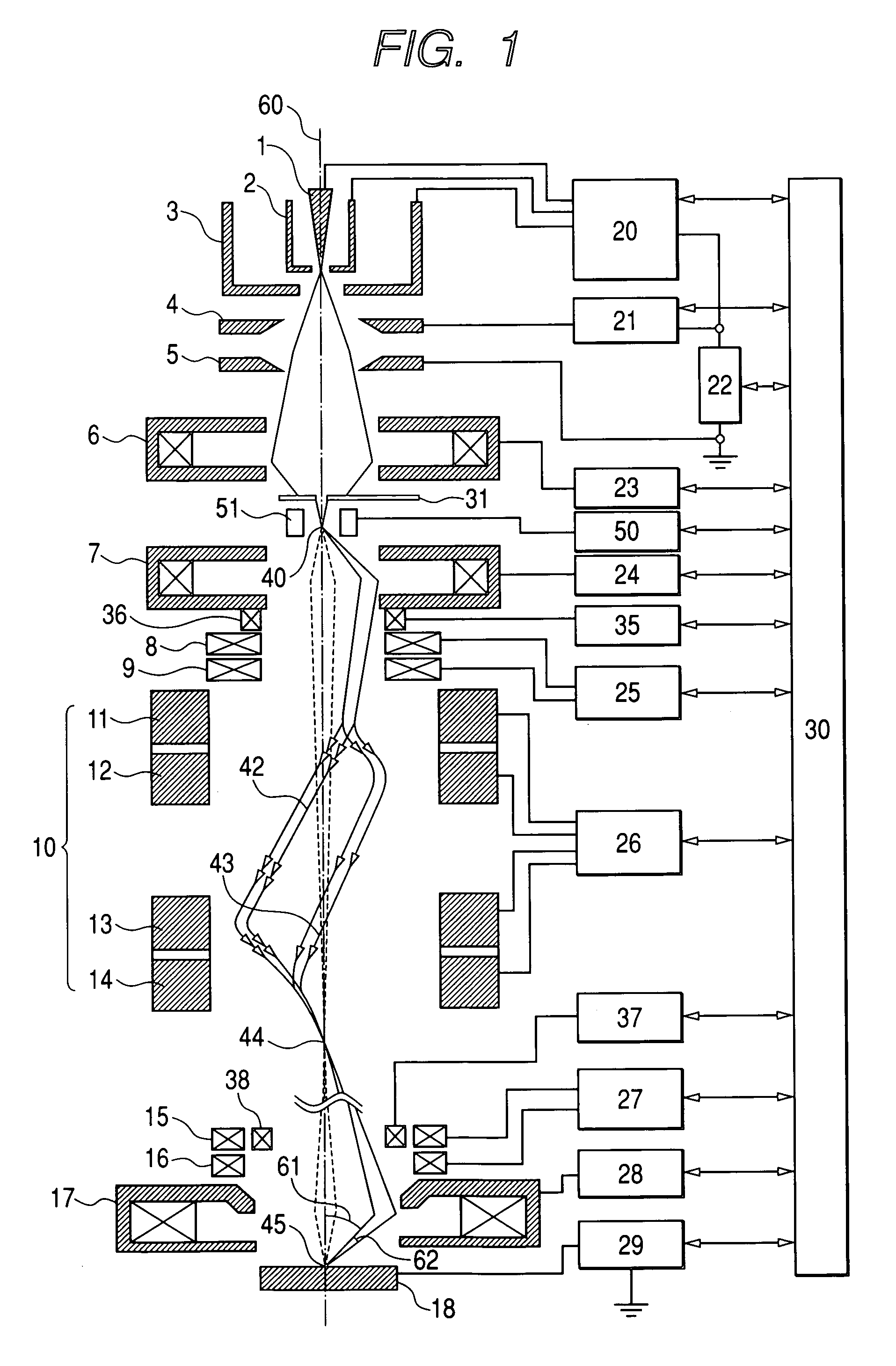Charged particle beam column
a charge particle and beam technology, applied in the direction of magnetic discharge control, instruments, heat measurement, etc., can solve the problems of affecting the integration the deformation of the resolution or displacement of the field of view which cannot be ignored, and the inability to affect the effect of the deflection uni
- Summary
- Abstract
- Description
- Claims
- Application Information
AI Technical Summary
Benefits of technology
Problems solved by technology
Method used
Image
Examples
first embodiment
[0029](First Embodiment)
[0030]FIG. 1 shows the outline configuration of an electron beam column in accordance with the first embodiment of the present invention and the trajectories of an electron beam.
[0031]A Schottky emitter 1 is an electron source that has oxygen and zirconium diffused into a tungsten single crystal and makes the most of the Schottky effect. A suppressor electrode 2 and an extraction electrode 3 are located near the Schottky emitter 1. The Schottky emitter 1 is heated and a voltage of about +2 kV is applied to the Schottky emitter 1 and the extraction electrode 3, whereby the Schottky emitter 1 radiates electrons due to the Schottky effect. A negative voltage is applied to the suppressor electrode 2 in order to suppress electrons radiated from any place other than the distal end of the Schottky emitter 1. Electrons coming out of the opening of the extraction electrode 3 are accelerated and converged by an electrostatic lens composed of a first anode 4 and a secon...
second embodiment
[0042](Second Embodiment)
[0043]FIG. 2 shows the outline configuration of the second embodiment of the present invention and trajectories of an electron beam.
[0044]The present embodiment does not include the deflector 51 included in the first embodiment shown in FIG. 1 but includes: a movable aperture 31 that limits the incident position of a charged particle beam entering the aberration corrector 10 and the quantity of the incident beam; and a control means for controlling the movable aperture 31 so as to modify the direction of emission from the object point 44 of the objective lens without shifting the object point 44 of the objective lens that lies on the optical axis, and that thus routes the charged particle beam to the objective lens 17. Thus, the charged particle beam is tilted and converged on the surface of a specimen at a predetermined angle.
[0045]In the drawing, a two-dimensional position control mechanism 32 moves the movable aperture 31 to a desired position on a plane ...
third embodiment
[0047](Third Embodiment)
[0048]FIG. 4 shows the configuration of the major portion of a CD-SEM (length measuring scanning electron microscope), to which the present invention is adapted, as the third embodiment of the present invention.
[0049]The CD-SEM comprises a chamber 90 the interior of which is deaerated to enter a vacuum, a computer 30, and various control power supplies (20 to 29, 35, 37, 50, 74, 75, and 81) to be controlled by the computer 30, an image processing unit 76, a monitor 77, and an auxiliary chamber (not shown) to be used to carry a specimen to the chamber 90. In addition to the electron beam column including the aberration corrector and being shown in FIG. 1, a mechanism for detecting secondary electrons that are generated when an electron beam is irradiated to a specimen and a specimen stage to be used to carry or move a specimen are incorporated in the chamber 90. A focused spot 45 of an electron beam is swept using the scanning deflectors 15 and 16 in order to ...
PUM
 Login to View More
Login to View More Abstract
Description
Claims
Application Information
 Login to View More
Login to View More - R&D
- Intellectual Property
- Life Sciences
- Materials
- Tech Scout
- Unparalleled Data Quality
- Higher Quality Content
- 60% Fewer Hallucinations
Browse by: Latest US Patents, China's latest patents, Technical Efficacy Thesaurus, Application Domain, Technology Topic, Popular Technical Reports.
© 2025 PatSnap. All rights reserved.Legal|Privacy policy|Modern Slavery Act Transparency Statement|Sitemap|About US| Contact US: help@patsnap.com



